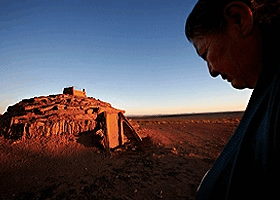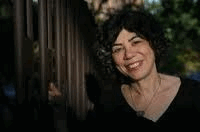Yellow Dirt
Air Date: Week of October 1, 2010

Pasternak's powerful four-part series for the Los Angeles Times won numerous awards. (Photo: Gail Fisher, LA Times)
In her new book “Yellow Dirt,” Judy Pasternak writes of a harrowing tale from Navajo country: how the U.S. government allowed uranium companies to walk away from hundreds of radioactive mines across the reservation. Not told of the danger, Navajos built their homes from the leftover ore and tailings. As Pasternak tells LOE’s Steve Curwood, four generations of people were sickened and are still being buried.
Transcript
GELLERMAN: It’s Living on Earth. I’m Bruce Gellerman. Judy Pasternak, a former investigative reporter with the Los Angeles Times, has written an epic story about US efforts to obtain uranium during the cold war. Her book, Yellow Dirt, chronicles how mining companies walked away, leaving radioactive ore and tailings behind. And 60 years later Americans in the southwest were still being exposed. Judy Pasternak spoke with Living on Earth’s Steve Curwood.
CURWOOD: You begin your story in Indian country in Arizona in the 1920s, 30s and 40s, and you found that some Navajo suspected that they might have some special rocks that outsiders coveted. What had they noticed?
PASTERNAK: They noticed these yellow stripes in the rock, powder-yellow stripes. And, really, the first people who settled this one valley that’s the central setting for my book- thought that this was gold.
CURWOOD: So, this is an area that white people call “Cane Valley,” where people noticed, the Navajo noticed these rocks. And, one of your main characters in this story of ‘yellow dirt’ tells his children, ‘Never ever tell any of the white men about these rocks.’ But, I guess, temptation eventually overtakes one of them.

Judy Pasternak's new book on uranium poisoning in Navajo country is just out.
PASTERNAK: Yeah, (laughs), his son, in fact, his favorite son. And, that was well before atomic bombs were being developed. But, later, during WWII, one of the Indian traders put some rocks, some samples, out on his counter, and he told the son, who was a customer, that this could be worth a lot of money.
CURWOOD: And, the son immediately goes out and…
PASTERNAK: Yeah…so…yes. So then he gathered up some of these rocks that were on the mason, and then brought them in.
CURWOOD: And it turns out this isn’t just any old uranium deposit, Judy, but this is the mother load of powerful uranium. Very rich uranium. What, hundreds of mines are blasted and tunneled across the land as a consequence as this.
PASTERNAK: Yeah, the Navajo reservation as a whole, really has world-class deposits of uranium. And, the mesa that rose above Cane Valley was the hottest, richest, most productive uranium mine on Navajo land.
CURWOOD: We know a fair amount about the miners- the health effects on them- but your book also documents, I think, for the first time…I’ve read this…maybe it’s in other material, about the broad range of suffering that the whole Navajo community suffered as a function of exposure. Tell us about the watering holes that were left from the surface mining, for example.

Author, Judy Pasternak.
PASTERNAK: There were huge open-pit uranium mines in the western part of the reservation because the deposit was so shallow- they could just blast it right out of the ground. When the mining companies left, according to their contract, they were supposed to return the land in as good condition as received. But nobody asked them to fill in these pits.
And, what happened was- they collected rain. And, these pits, some of them were half a mile long. They looked like lakes in the desert, they looked like oasis. So, shepherds who were coming by were actually pretty grateful for their presence because all of a sudden here was a water supply in the desert. And, so, they would drink. They would water their herds there and they would drink themselves.
CURWOOD: And, in Navajo culture, the shepherds are often women.
PASTERNAK: That’s right, and some of those women were pregnant.
CURWOOD: What happened to them?
PASTERNAK: There is a correlation between women who drank contaminated water while they were pregnant and a syndrome that’s known as ‘Navajo Neurapathy’. Children who have this, generally the average age of death is ten. Some lived into their thirties. They had fused, stiffened, fingers and toes that were kind of like claws. Many of them had liver damage- also they had problems with the nerves in their corneas, so often it was hard for them to see.
CURWOOD: The average age of death was ten?
PASTERNAK: That’s right.
CURWOOD: And then, abruptly, in the late 1960’s the Cold War is over, the government has enough uranium, thank you. Basically the mines close up and this is so damning, the government, which is the legal guardian of the tribe, just allows these mining companies to walk away.
PASTERNAK: Yeah, that’s correct. And, the mines themselves, the portals were left open. Anybody could wander in. There were great piles of waste rock around and there were these large hills or small mountains of sandy waste, radioactive waste.
CURWOOD: I imagine kids played in this stuff then?
PASTERNAK: That’s correct. And they predicted that kids might play on them, and indeed they did. They used to dig caves in them in the summertime. And, in the wintertime, they were a wonderful attraction, you know, it was the only place around to go sledding.
The way Navajo’s lived their lives gave them a much greater exposure than people in a town or city would have. They also used the ore, because they were very practical and also very poor. They used the ore, which had been nicely squared off by the blasting to build foundations for their houses, and fireplaces and bread ovens. They used these sandy leftovers from the four processing mills that were on the reservation to mix cement, and it got a reputation for making really nice, smooth cement. So they used it for floors that they slept directly on, and stucco walls. So, they brought this stuff into their daily lives, into their homes.

Pasternak's powerful four-part series for the Los Angeles Times won numerous awards.
(Photo: Gail Fisher, LA Times)
CURWOOD: So, Navajo are making homes out of uranium and other related, other radioactive materials.
PASTERNAK: Yeah. In essence, they were living in another mine.
CURWOOD: Meanwhile, of course, the largely white uranium towns in Colorado, like Grand Junction, are getting cleaned up.
PASTERNAK: Right. And, a lot of that was a matter of having political clout. Grand Junction had a processing mill in town, and when it was realized that people had been coming in and taking some of the sand to use in construction, the federal government spent 250 million dollars taking the contaminated stuff out of the homes of thousands there. They went house to house, where they dug up contaminated soil, they would replace the trees and the grass. But, at the same time, Navajo’s were actually using the material to put it into their homes.
CURWOOD: Your series of articles runs in the Los Angeles Times, what in 2006, and some wheels began to turn after that. Tell us what happened.
PASTERNAK: One thing that happened, was that Congressman Henry Waxman read the series and he thought that, actually, other members of Congress who had Navajo constituents, might do something, but nothing much happened. And part of that is that there isn’t anybody who really represents the whole reservation. And so, Waxman decided after awhile that he was going to do something about it because he found it embarrassing- the situation.
CURWOOD: Now, if this time Congressman Waxman, who is a Democrat from California, is what, chairing the house oversight committee?
PASTERNAK: Well, yeah, with the oversight committee. And so, he basically, his jurisdiction was, as he put it, everything. They had a hearing, for the first time they brought a number of federal agencies to account together. It was hard to point fingers when the others were there. But, he did something that was also pretty unusual.
He also followed up after the hearing- he has since continued to bring these people together for meetings, including the Navajo tribe there, and the various agencies. And he has pushed them to come up with a five-year, multi-agency cleanup plan, which probably won’t do the whole job, but getting some momentum going- it’s now in year two.
CURWOOD: I believe you say in your book that Navajo official, he had what, a Geiger counter at this congressional hearing?
PASTERNAK: Yeah, he brought the soil in. And they had had to inform the capital police ahead of time, and he ran a Geiger counter over this container of material, and the noise of the clicks just filled the room. The police immediately took it and got it out of there- ‘time to go!’ (Laughs).
CURWOOD: Time to go. And so, after Congressman Waxman’s hearings, and your story- I gather slowly, some of these radioactive homes, what is now a fourth generation of Navajo’s sleeping in them- they’re getting cleaned up?
PASTERNAK: Yeah. I had the pleasure last fall of tagging along with someone from the US EPA and the Navajo EPA as they were giving out keys to new, safe homes, to people whose contaminated houses had been knocked down. And, they were pretty shocked people to find that something was actually happening, after all this time. It was bittersweet though, because people had died, in the meantime.
CURWOOD: Judy, thanks so much for taking the time with me today.
PASTERNAK: Thank you very much for having me on the show.
GELLERMAN: Living on Earth’s Steve Curwood and author Judy Pasternak. Her new book is “Yellow Dirt, an American story of a Poisoned Land and a People Betrayed”.
Links
Read Judy Pasternak’s four part series, “A peril that dwelt among the Navajos”
Living on Earth wants to hear from you!
Living on Earth
62 Calef Highway, Suite 212
Lee, NH 03861
Telephone: 617-287-4121
E-mail: comments@loe.org
Newsletter [Click here]
Donate to Living on Earth!
Living on Earth is an independent media program and relies entirely on contributions from listeners and institutions supporting public service. Please donate now to preserve an independent environmental voice.
NewsletterLiving on Earth offers a weekly delivery of the show's rundown to your mailbox. Sign up for our newsletter today!
 Sailors For The Sea: Be the change you want to sea.
Sailors For The Sea: Be the change you want to sea.
 The Grantham Foundation for the Protection of the Environment: Committed to protecting and improving the health of the global environment.
The Grantham Foundation for the Protection of the Environment: Committed to protecting and improving the health of the global environment.
 Contribute to Living on Earth and receive, as our gift to you, an archival print of one of Mark Seth Lender's extraordinary wildlife photographs. Follow the link to see Mark's current collection of photographs.
Contribute to Living on Earth and receive, as our gift to you, an archival print of one of Mark Seth Lender's extraordinary wildlife photographs. Follow the link to see Mark's current collection of photographs.
 Buy a signed copy of Mark Seth Lender's book Smeagull the Seagull & support Living on Earth
Buy a signed copy of Mark Seth Lender's book Smeagull the Seagull & support Living on Earth

